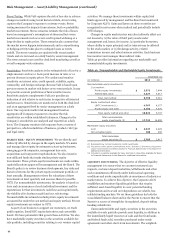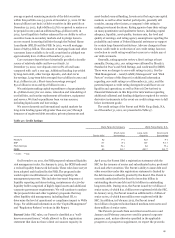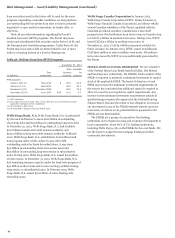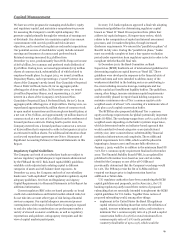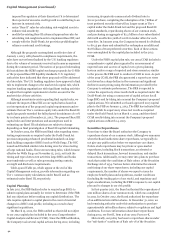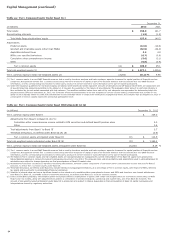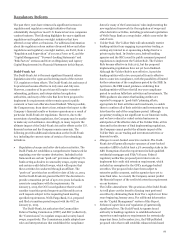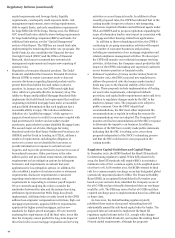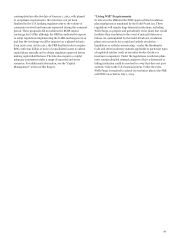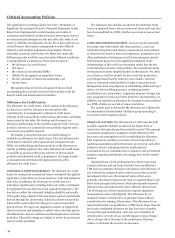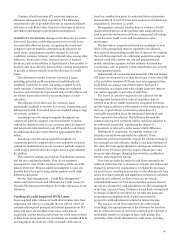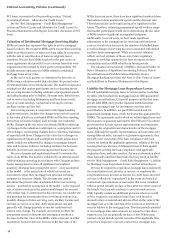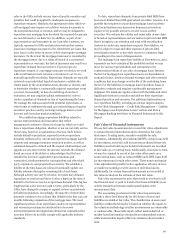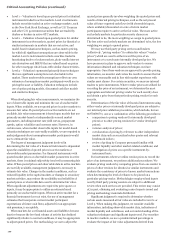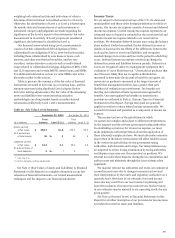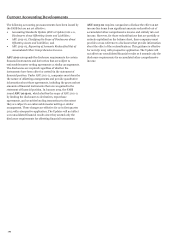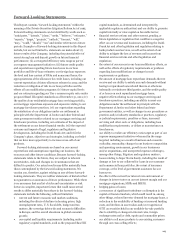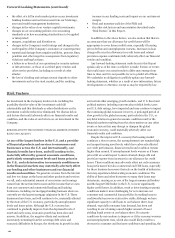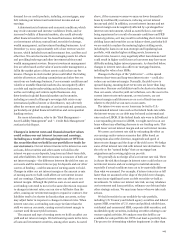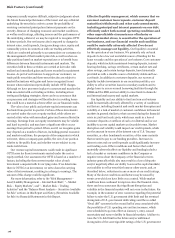Wells Fargo 2012 Annual Report Download - page 98
Download and view the complete annual report
Please find page 98 of the 2012 Wells Fargo annual report below. You can navigate through the pages in the report by either clicking on the pages listed below, or by using the keyword search tool below to find specific information within the annual report.
Critical Accounting Policies
Our significant accounting policies (see Note 1 (Summary of
Significant Accounting Policies) to Financial Statements in this
Report) are fundamental to understanding our results of
operations and financial condition because they require that we
use estimates and assumptions that may affect the value of our
assets or liabilities and financial results. Six of these policies are
critical because they require management to make difficult,
subjective and complex judgments about matters that are
inherently uncertain and because it is likely that materially
different amounts would be reported under different conditions
or using different assumptions. These policies govern:
x the allowance for credit losses;
x PCI loans;
x the valuation of residential MSRs;
x liability for mortgage loan repurchase losses;
x the fair valuation of financial instruments; and
x income taxes.
Management has reviewed and approved these critical
accounting policies and has discussed these policies with the
Board’s Audit and Examination Committee.
Allowance for Credit Losses
The allowance for credit losses, which consists of the allowance
for loan losses and the allowance for unfunded credit
commitments, is management’s estimate of credit losses
inherent in the loan portfolio at the balance sheet date, excluding
loans carried at fair value. We develop and document our
allowance methodology at the portfolio segment level. Our loan
portfolio consists of a commercial loan portfolio segment and a
consumer loan portfolio segment.
We employ a disciplined process and methodology to
establish our allowance for credit losses. The total allowance for
credit losses considers both impaired and unimpaired loans.
While our methodology attributes portions of the allowance to
specific portfolio segments, the entire allowance for credit losses
is available to absorb credit losses inherent in the total loan
portfolio and unfunded credit commitments. No single statistic
or measurement determines the appropriateness of the
allowance for credit losses.
COMMERCIAL PORTFOLIO SEGMENT The allowance for credit
losses for unimpaired commercial loans is estimated through the
application of loss factors to loans based on credit risk ratings for
each loan. In addition, the allowance for credit losses for
unfunded commitments, including letters of credit, is estimated
by applying these loss factors to loan equivalent exposures. The
loss factors reflect the estimated default probability and quality
of the underlying collateral. The loss factors used are statistically
derived through the observation of historical losses incurred for
loans within each credit risk rating over a relevant specified
period of time. We apply our judgment to adjust or supplement
these loss factors and estimates to reflect other risks that may be
identified from current conditions and developments in selected
portfolios. These risk ratings are subject to review by an internal
team of credit specialists.
The allowance also includes an amount for estimated credit
losses on impaired loans such as nonaccrual loans and loans that
have been modified in a TDR, whether on accrual or nonaccrual
status.
CONSUMER PORTFOLIO SEGMENT Loans are pooled generally
by product type with similar risk characteristics. Losses are
estimated using forecasted losses to represent our best estimate
of inherent loss based on historical experience, quantitative and
other mathematical techniques over the loss emergence period.
Each business group exercises significant judgment in the
determination of the credit loss estimation model that fits the
credit risk characteristics of its portfolio. We use both internally
developed and vendor supplied models in this process. We often
use roll rate or net flow models for near-term loss projections,
and vintage-based models, behavior score models, and time
series or statistical trend models for longer-term projections.
Management must use judgment in establishing additional input
metrics for the modeling processes, considering further
stratification into sub-product, origination channel, vintage, loss
type, geographic location and other predictive characteristics. In
addition, we establish an allowance for consumer loans modified
in a TDR, whether on accrual or nonaccrual status.
The models used to determine the allowance are validated by
an independent internal model validation group operating in
accordance with Company policies.
OTHER ACL MATTERS The allowance for credit losses for both
portfolio segments includes an amount for imprecision or
uncertainty that may change from period to period. This amount
represents management’s judgment of risks inherent in the
processes and assumptions used in establishing the allowance.
This imprecision considers economic environmental factors,
modeling assumptions and performance, process risk, and other
subjective factors, including industry trends and risk
assessments for our commitments to regulatory and government
agencies regarding settlements of mortgage foreclosure-related
matters.
Impaired loans, which predominantly include nonaccrual
commercial loans and any loans that have been modified in a
TDR have an estimated allowance calculated as the difference, if
any, between the impaired value of the loan and the recorded
investment in the loan. The impaired value of the loan is
generally calculated as the present value of expected future cash
flows from principal and interest, which incorporates expected
lifetime losses, discounted at the loan’s effective interest rate.
The development of these expectations requires significant
management review and judgment. The allowance for an
unimpaired loan is based solely on principal losses without
consideration for timing of those losses. The allowance for an
impaired loan that was modified in a TDR may be lower than the
previously established allowance for that loan due to benefits
received through modification, such as lower probability of
default and/or severity of loss, and the impact of prior charge-
offs or charge-offs at the time of the modification that may
reduce or eliminate the need for an allowance.
96


